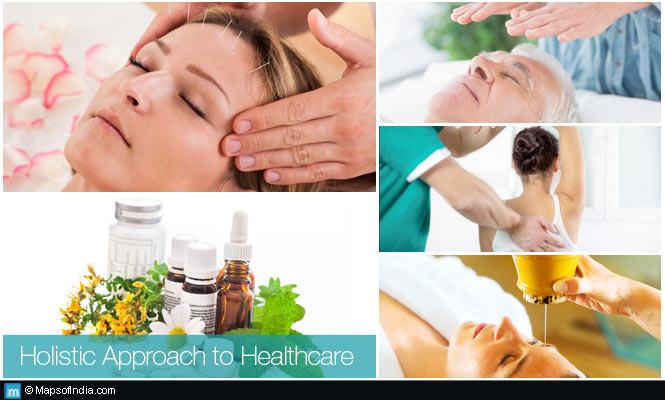 These days, it is a norm to have an alternative therapy unit in all leading multi-specialty hospitals. The medical sector, albeit slowly, is realising that a syndromal or disease-specific approach to heal patients offers only partial relief to the patient and his family. A holistic approach to healthcare is what is practised these days. The concept of treating the patient as an individual with his or her unique set of characteristics, body constitution and cultural beliefs is central to the treatment process.
These days, it is a norm to have an alternative therapy unit in all leading multi-specialty hospitals. The medical sector, albeit slowly, is realising that a syndromal or disease-specific approach to heal patients offers only partial relief to the patient and his family. A holistic approach to healthcare is what is practised these days. The concept of treating the patient as an individual with his or her unique set of characteristics, body constitution and cultural beliefs is central to the treatment process.
What is Complementary and Alternative Medicine (CAM)?
There are a number of stand-alone holistic treatment centres mushrooming all over our urban landscape. Along with Ayurvedic therapies, which are hugely popular among foreign tourists, these places offer a host of other complementary therapies. Together, these therapies are given the name of Complementary and Alternative Medicine (CAM), particularly in the West.
While complementary therapies are those that are tried in conjunction with the traditional or allopathic treatments, alternative therapies are undertaken on their own. Collectively, all these therapies are part of the holistic medical care, which is also termed as Integrative Medicine.
The following are some of the examples out of the hundreds of CAMs that are in vogue worldwide:
- Those that act on mind and body: These treatments look at the relationship between emotional and physical states. Examples include meditative techniques, acupuncture, relaxation and artistic therapies
- Whole medical systems: They are separate specialties in themselves and an alternative to traditional medical systems. Ayurveda, Chinese traditional medicine, homeopathy and naturopathy are some of the examples.
- Physical practices: These practices look at improving health through external manipulations like chiropractic treatment and osteopathy.
- Energy therapies: These therapies modify the bio-energy fields that are said to surround the human body. Magnet therapy, Reiki and Pranic healing are such therapies.
- Biological therapies: Positive effects of vitamins, minerals and diet are employed in these therapies. Megavitamin therapy and herbal medicine represent this domain.
Criticism of Complementary and Alternative Medicine
The allopathic practitioners criticise CAMs as they lack any robust evidence base in their favour. It is only recently that CAMs are being studied with scientific research methods. As the data accumulate, it would be interesting to do a comparative study of the beneficial effects of these therapies and allopathic treatment. The findings of the research are likely to reveal the level of patient satisfaction achieved with these therapies.
It is also worth noting that CAMs are mostly useful for chronic conditions that afflict us, rather than in emergent conditions where there is no alternative to critical allopathic care. Another barb that is fired in the direction of CAMs is that their mechanism of action is unknown, and the patients using them may be vulnerable to unknown or unforeseen side-effects.
Since most of these therapies take a long time to prove beneficial, the patients cannot expect to get immediate relief.. Moreover, what works for one patient may not work for another, or may even cause harm to another individual.
All of these, could very well be said about allopathic therapies as well. At a convention of physicians in the UK, homeopathy was famously declared as ‘witchcraft’ a few years ago. Practitioners of traditional medicine would do well to remember that the drugs they prescribe also do not carry any guarantee of providing permanent relief to the patient’s chronic suffering, and are often used only for symptomatic relief. They also come with their own set of adverse effects, some of which are very serious. For example, aspirin, which is routinely used in patients with heart disease, can cause severe gastric bleeding.
Since the body constitution and genetic makeup varies from patient to patient, it is difficult to predict the outcome – good or bad – with allopathic drugs as well. Therefore it augurs well for healthcare professionals to keep an open mind about all therapies, and barring emergencies, the patient should be allowed the freedom to select the type of therapy that best suits him or her.
What applies to the healthcare professionals, may very well apply to patients as well. Even patients should keep their mind free of preconceptions.
Exercise Caution While Choosing Complementary and Alternative Medicine
Here is a checklist of things to look out for while deciding what sort of alternative therapy may be suitable for you:
- Do your research: Find out about the therapy, the therapist who would be working on your case, his credentials and experience, feedback from other patients, the duration of treatment, adverse effects, and the cost of therapy.
- Go prepared: Carry a list of questions to be answered when you go for your first consultation; clear your doubts; be convinced that the therapy is right for you and ask for a demonstration or reference if necessary.
- Keep your therapist informed: Remember to tell the therapists about the pre-existing ailments for which you might be undergoing treatment and the allopathic drugs that you are already taking.
- Stick to one therapy at a time: Mixing two or three alternative therapies or allopathic treatments is ill-advised and may lead to serious complications.
- Phase out a therapy: If you think that a particular therapy is not working for you and you want to try other options, discuss this with your therapist and get an idea on how you can go about doing this.
- Avoid dubious therapies: Some therapies promise a lot but deliver very little; They are only out to make money at the expense of your health.
Finally, remember that as far as complementary and alternative therapies are concerned, it is about finding the right treatment for a particular condition in a particular patient.
Read more:
Green Tea: Types, Benefits and Side Effects
How to Prevent Hair Loss in 10 Tested Ways?
Discover Which Type of Yoga Suits You?
Natural Drinks and Foods for Liver Detoxification
Home Remedies to Stop the Signs of Ageing




